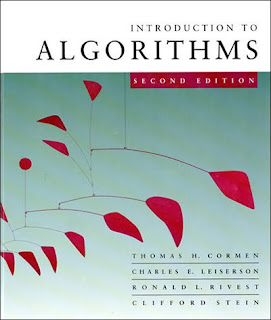Introduction to Algorithms, Second Edition Ebook: (posted by Free Downloadable Books|BSCS|C programming|BCS|physics|calculus|Free Books|Free ebooks|C++|http://hidden-science.blogspot.com/ )
>> Sunday, May 23, 2010
McGraw-Hill Science/Engineering/Math; 2 edition | ISBN: 0070131511 | 1056 pages | July 16, 2001 | CHM
The updated new edition of the classic Introduction to Algorithms is intended primarily for use in undergraduate or graduate courses in algorithms or data structures. Like the first edition, this text can also be used for self-study by technical professionals since it discusses engineering issues in algorithm design as well as the mathematical aspects.
In its new edition, Introduction to Algorithms continues to provide a comprehensive introduction to the modern study of algorithms. The revision has been updated to reflect changes in the years since the book’s original publication. New chapters on the role of algorithms in computing and on probabilistic analysis and randomized algorithms have been included. Sections throughout the book have been rewritten for increased clarity, and material has been added wherever a fuller explanation has seemed useful or new information warrants expanded coverage.
This part will get you started in thinking about designing and analyzing algorithms. It is intended to be a gentle introduction to how we specify algorithms, some of the design strategies we will use throughout this book, and many of the fundamental ideas used in algorithm analysis. Later parts of this book will build upon this base. Chapter 1 is an overview of algorithms and their place in modern computing systems. This chapter defines what an algorithm is and lists some examples. It also makes a case that algorithms are a technology, just as are fast hardware, graphical user interfaces, object-oriented systems, and networks. In Chapter 2, we see our first algorithms, which solve the problem of sorting a sequence of n numbers. They are written in a pseudocode which, although not directly translatable to any conventional programming language, conveys the structure of the algorithm clearly enough that a competent programmer can implement it in the language of his choice. The sorting algorithms we examine are insertion sort, which uses an incremental approach, and merge sort, which uses a recursive technique known as “divide and conquer.” Although the time each requires increases with the value of n, the rate of increase differs between the two algorithms. We determine these running times in Chapter 2, and we develop a useful notation to express them. Chapter 3 precisely defines this notation, which we call asymptotic notation. It starts by defining several asymptotic notations, which we use for bounding algorithm running times from above and/or below. The rest of Chapter 3 is primarily a presentation of mathematical notation. Its purpose is more to ensure that your use of notation matches that in this book than to teach you new mathematical concepts.
DOWNLOAD HERE
The updated new edition of the classic Introduction to Algorithms is intended primarily for use in undergraduate or graduate courses in algorithms or data structures. Like the first edition, this text can also be used for self-study by technical professionals since it discusses engineering issues in algorithm design as well as the mathematical aspects.
In its new edition, Introduction to Algorithms continues to provide a comprehensive introduction to the modern study of algorithms. The revision has been updated to reflect changes in the years since the book’s original publication. New chapters on the role of algorithms in computing and on probabilistic analysis and randomized algorithms have been included. Sections throughout the book have been rewritten for increased clarity, and material has been added wherever a fuller explanation has seemed useful or new information warrants expanded coverage.
This part will get you started in thinking about designing and analyzing algorithms. It is intended to be a gentle introduction to how we specify algorithms, some of the design strategies we will use throughout this book, and many of the fundamental ideas used in algorithm analysis. Later parts of this book will build upon this base. Chapter 1 is an overview of algorithms and their place in modern computing systems. This chapter defines what an algorithm is and lists some examples. It also makes a case that algorithms are a technology, just as are fast hardware, graphical user interfaces, object-oriented systems, and networks. In Chapter 2, we see our first algorithms, which solve the problem of sorting a sequence of n numbers. They are written in a pseudocode which, although not directly translatable to any conventional programming language, conveys the structure of the algorithm clearly enough that a competent programmer can implement it in the language of his choice. The sorting algorithms we examine are insertion sort, which uses an incremental approach, and merge sort, which uses a recursive technique known as “divide and conquer.” Although the time each requires increases with the value of n, the rate of increase differs between the two algorithms. We determine these running times in Chapter 2, and we develop a useful notation to express them. Chapter 3 precisely defines this notation, which we call asymptotic notation. It starts by defining several asymptotic notations, which we use for bounding algorithm running times from above and/or below. The rest of Chapter 3 is primarily a presentation of mathematical notation. Its purpose is more to ensure that your use of notation matches that in this book than to teach you new mathematical concepts.
DOWNLOAD HERE







0 comments:
Post a Comment